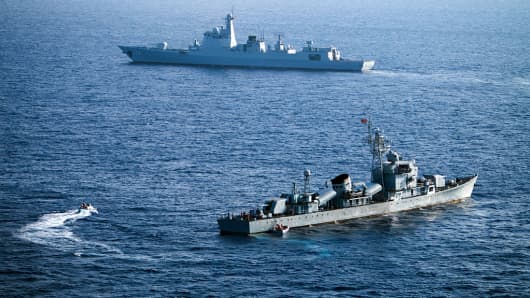By Kristin Huang

This photo taken on May 5, 2016 shows crew members of China's South Sea Fleet taking part in a drill in the Paracel Islands in the South China Sea.

Satellite images suggest China has upgraded its military infrastructure in the disputed Paracel Islands (Hoàng Sa) in the South China Sea.
The Asia Maritime Transparency Initiative at the Centre for Strategic and International Studies in Washington said on Wednesday that China now occupied 20 outposts in the Paracels, and that there had been an extensive military build-up on eight islands.
"Three of these now have protected harbors capable of hosting large numbers of naval and civilian vessels. Four others boast smaller harbors, with a fifth under construction at Drummond Island (đảo Duy Mộng)," the group said on its website.
"Five of the islands contain helipads, with Duncan Island (đảo Quang Hoà) housing a full helicopter base. And the largest of the Paracels, Woody Island (đảo Phú Lâm), sports an airstrip, hangars and a [detachment] of HQ-9 surface-to-air missile batteries."

This photo taken on May 5, 2016 shows crew members of China's South Sea Fleet taking part in a drill in the Paracel Islands in the South China Sea.

Satellite images suggest China has upgraded its military infrastructure in the disputed Paracel Islands (Hoàng Sa) in the South China Sea.
The Asia Maritime Transparency Initiative at the Centre for Strategic and International Studies in Washington said on Wednesday that China now occupied 20 outposts in the Paracels, and that there had been an extensive military build-up on eight islands.
"Three of these now have protected harbors capable of hosting large numbers of naval and civilian vessels. Four others boast smaller harbors, with a fifth under construction at Drummond Island (đảo Duy Mộng)," the group said on its website.
"Five of the islands contain helipads, with Duncan Island (đảo Quang Hoà) housing a full helicopter base. And the largest of the Paracels, Woody Island (đảo Phú Lâm), sports an airstrip, hangars and a [detachment] of HQ-9 surface-to-air missile batteries."
The group said further expansion could help Beijing consolidate its presence and project its power in the region.
"Not all of China's outposts in the Paracels currently house significant infrastructure, and many contain no more than one or two buildings … but the presence of small buildings and construction materials suggests China may be preparing to expand those features," the group said.
"This is part of China's broader efforts to consolidate its grip on adjacent waters and disputed islands," said Richard Heydarian, a political science professor at De La Salle University in Manila.
China has repeatedly promised it would not militarise its man-made islands in the South China Sea.
The think tank claimed in December that Beijing had placed weaponry on seven of the artificial islands it had built in the region.
At that time, China replied: "The necessary military facilities are mainly for self defense. When someone is flexing muscles at your doorstep, wouldn't you prepare a slingshot?"
China's strengthening of its armed forces and increasingly assertive claims to most of the South China Sea have created unease among its neighbors and the United States.
Chinese analysts say U.S. President Donald Trump's aggressive stance towards China is one of the things triggering its actions.
"That's how China reacts to the outside world. If Trump did not make irresponsible anti-China remarks, the militarization of artificial islands in South China Sea would be delayed," Zhou Chenming, from the think tank Knowfar Institute for Strategic and Defence Studies, said.
"The situation now is particularly tense," Kerry Brown, professor of Chinese Studies and director of the Lau China Institute at King's College in London, said.
"The bottom line is that China believes this area is its own backyard for it to do as it pleases, and the US and others fundamentally disagree," Brown said.
"It is hard to see an easy way of bridging the divide between these two positions."
"Not all of China's outposts in the Paracels currently house significant infrastructure, and many contain no more than one or two buildings … but the presence of small buildings and construction materials suggests China may be preparing to expand those features," the group said.
"This is part of China's broader efforts to consolidate its grip on adjacent waters and disputed islands," said Richard Heydarian, a political science professor at De La Salle University in Manila.
China has repeatedly promised it would not militarise its man-made islands in the South China Sea.
The think tank claimed in December that Beijing had placed weaponry on seven of the artificial islands it had built in the region.
At that time, China replied: "The necessary military facilities are mainly for self defense. When someone is flexing muscles at your doorstep, wouldn't you prepare a slingshot?"
China's strengthening of its armed forces and increasingly assertive claims to most of the South China Sea have created unease among its neighbors and the United States.
Chinese analysts say U.S. President Donald Trump's aggressive stance towards China is one of the things triggering its actions.
"That's how China reacts to the outside world. If Trump did not make irresponsible anti-China remarks, the militarization of artificial islands in South China Sea would be delayed," Zhou Chenming, from the think tank Knowfar Institute for Strategic and Defence Studies, said.
"The situation now is particularly tense," Kerry Brown, professor of Chinese Studies and director of the Lau China Institute at King's College in London, said.
"The bottom line is that China believes this area is its own backyard for it to do as it pleases, and the US and others fundamentally disagree," Brown said.
"It is hard to see an easy way of bridging the divide between these two positions."
Aucun commentaire:
Enregistrer un commentaire